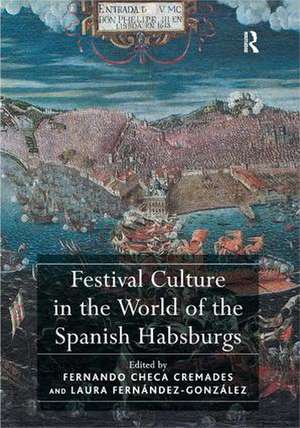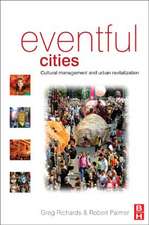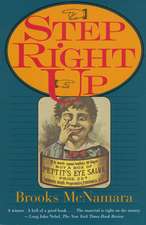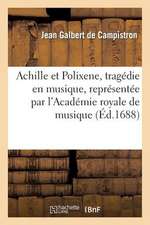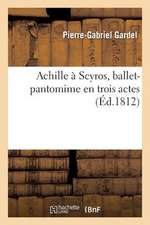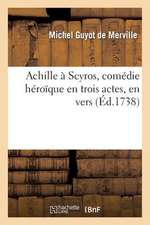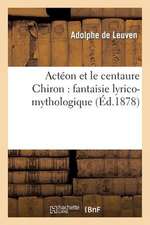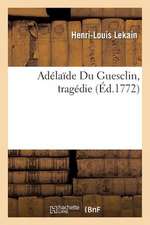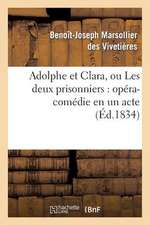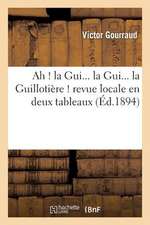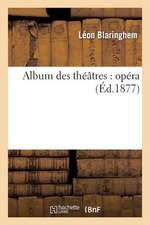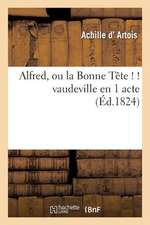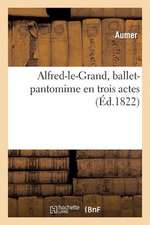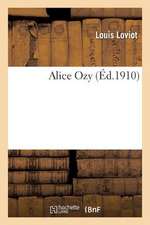Festival Culture in the World of the Spanish Habsburgs
Autor Fernando Checa Cremades, Laura Fernández–Gonzálezen Limba Engleză Hardback – 28 oct 2015
| Toate formatele și edițiile | Preț | Express |
|---|---|---|
| Paperback (1) | 312.97 lei 3-5 săpt. | +28.30 lei 5-11 zile |
| Taylor & Francis – 14 oct 2024 | 312.97 lei 3-5 săpt. | +28.30 lei 5-11 zile |
| Hardback (1) | 773.18 lei 6-8 săpt. | |
| Taylor & Francis – 28 oct 2015 | 773.18 lei 6-8 săpt. |
Preț: 773.18 lei
Preț vechi: 1108.05 lei
-30% Nou
Puncte Express: 1160
Preț estimativ în valută:
147.99€ • 160.81$ • 124.40£
147.99€ • 160.81$ • 124.40£
Carte tipărită la comandă
Livrare economică 21 aprilie-05 mai
Preluare comenzi: 021 569.72.76
Specificații
ISBN-13: 9781409435617
ISBN-10: 140943561X
Pagini: 322
Dimensiuni: 174 x 246 x 26 mm
Greutate: 0.95 kg
Ediția:1
Editura: Taylor & Francis
Colecția Routledge
Locul publicării:Oxford, United Kingdom
ISBN-10: 140943561X
Pagini: 322
Dimensiuni: 174 x 246 x 26 mm
Greutate: 0.95 kg
Ediția:1
Editura: Taylor & Francis
Colecția Routledge
Locul publicării:Oxford, United Kingdom
Public țintă
AcademicCuprins
Foreword, Teófilo F. Ruiz; Introduction. Part I Habsburg Visual Culture: Tapestries, Paintings and Festivals at Court: The language of triumph: images of war and victory in two early modern tapestry series, Fernando Checa Cremades; The ceremonial decoration of the Alcázar in Madrid: the use of tapestries and paintings in Habsburg festivities, Miguel A. Zalama Rodríguez. Part II Entries, Sojourns and the Wider Triumphal Culture in the Habsburg World: Festival interventions in the urban space of Habsburg Madrid, David Sánchez Cano; Negotiating terms: King Philip I of Portugal and the ceremonial entry of 1581 into Lisbon, Laura Fernández-González; The loose parts of an entry: the flop of Cremona in 1598, Maria Ines Aliverti; Margaret of Austria’s travel in the state of Milan between 1598 and 1599, Franca Varallo; Routes and triumphs of Habsburg power in colonial America, Victor Mínguez Cornelles. Part III Religion and Empire: Processions, Funerals and the Spanish Monarchy: The ceremonial king: kingly rituals and imperial power in 17th-century New World cities, Alejandra B. Osorio; Festivals and hagiography in the Spanish court (1565-1615), Juan Luis González García; Corpus Christi in Spanish Palermo: two baroque apparati by Giacomo Amato for the Duke of Uceda (Viceroy of Sicily, 1687-1696), Sabina de Cavi. Part IV Music and Art in the Service of the Spanish Habsburgs: Music in the service of the Spanish hegemony in early modern Rome, Noel O’Regan; Royal festivals in mid-17th-century Naples: the image of the Spanish Habsburg kings in the work of Italian and Spanish artists, Ida Mauro. Bibliography; Index.
Notă biografică
Fernando Checa Cremades is a full Professor of History of Art at the University Complutense in Madrid and a former director of the Prado Museum in Madrid, Spain. Checa is recipient of the prestigious National Prize in History awarded by the Spanish Ministry of Culture for his ground-breaking study on Philip II of Spain as patron of the arts (Felipe II. Mecenas de las Artes). Fernando has published extensively on the artistic and cultural patronage of the Spanish House of Habsburg, especially during the rule of Emperor Charles V and Philip II of Spain. Checa is an active guest curator having curated major exhibitions on the royal collections of the Habsburgs and their extended family. Checa’s most recent monograph explores Titian’s production for the European courts (Tiziano y las Cortes del Renacimiento). Dr Laura Fernández-González is a Lecturer in the School of History & Heritage, College of Arts at the University of Lincoln. She has held post-doctoral fellowships at the Institute for Advance Research in the Humanities (University of Edinburgh) and the Calouste Gulbenkian Foundation in Lisbon (Portugal). Laura’s research programme and publication record concern cultural exchange, the relationship between centres and peripheries, and how these tensions are reflected in the artistic and architectural production of the early modern Spanish and Portuguese global empires. Laura graduated with PhD from the University of Edinburgh in 2012, and her thesis was a recipient of a ’Dissertation award: Honourable mention’ awarded by the Association of Spanish and Portuguese Historical Studies (ASPHS). She was convenor of the international conference on festivals of the Spanish Habsburgs in Edinburgh that was the origin of the present book.
Recenzii
These twelve essays provide an insightful foundation for more extensive study. The authors’ diverse case studies explore a variety of themes and debates over the course of the book and thereby make an important contribution to both festival studies and the cultural dimensions of Habsburg hegemony.
-Jeremy Roe, Universidade Nova de Lisbo
"Festival Culture in the World of the Spanish Habsburgs is a must. This is a superb exploration of the monarchy’s pluralistic language of self-representation through local and transnational cultural events articulated in the visual, historical, religious, musical, print, literary, and ephemeral forms. The result is an exhilarating and compelling book with an original approach to the culture of festivals in the Spanish empire during the Habsburg dynasty.’ Carmen Fracchia, Birkbeck, University of London, UK ’This stimulating book presents the triumphant worlds of the Spanish Habsburgs through a myriad of historical perspectives, embracing Iberia, Rome, Milan, Palermo and Spanish America. Painting, sculpture, architecture and music are examined through the lens of festivals and celebrations during the baroque period. Edited by two experts in the field, with contributions by leading scholars, this will be an enormously useful work of reference for scholars and students alike." - Marjorie Trusted, Victoria and Albert Museum, London, UK
"This edited collection makes a significant contribution to several areas of study. In treating Spanish Habsburg festivals as part of "one cultural system", it advances the scholarship of these ceremonies beyond the geographical compartmentalization that charactized the field. (...) To read this book is to encounter the early modern festival in all its richness and complexity." - Linda Briggs, University of Manchester, UK
-Jeremy Roe, Universidade Nova de Lisbo
"Festival Culture in the World of the Spanish Habsburgs is a must. This is a superb exploration of the monarchy’s pluralistic language of self-representation through local and transnational cultural events articulated in the visual, historical, religious, musical, print, literary, and ephemeral forms. The result is an exhilarating and compelling book with an original approach to the culture of festivals in the Spanish empire during the Habsburg dynasty.’ Carmen Fracchia, Birkbeck, University of London, UK ’This stimulating book presents the triumphant worlds of the Spanish Habsburgs through a myriad of historical perspectives, embracing Iberia, Rome, Milan, Palermo and Spanish America. Painting, sculpture, architecture and music are examined through the lens of festivals and celebrations during the baroque period. Edited by two experts in the field, with contributions by leading scholars, this will be an enormously useful work of reference for scholars and students alike." - Marjorie Trusted, Victoria and Albert Museum, London, UK
"This edited collection makes a significant contribution to several areas of study. In treating Spanish Habsburg festivals as part of "one cultural system", it advances the scholarship of these ceremonies beyond the geographical compartmentalization that charactized the field. (...) To read this book is to encounter the early modern festival in all its richness and complexity." - Linda Briggs, University of Manchester, UK
Descriere
Festivals and ceremonials played a major role in the Spanish world; through them local identities as well as a common Spanish culture made their presence manifest within and beyond the peninsula through ephemeral displays, music and print. This book explores Habsburg Visual culture at court and its connection with the creation of a language of triumph, the relationship between religion and the empire, and examines cultural, artistic and musical exchange in Naples and Rome. Taken together these essays contribute further to our growing appreciation of the importance of early-modern festival culture in general, and their significance in the world of the Spanish Habsburgs in particular.
